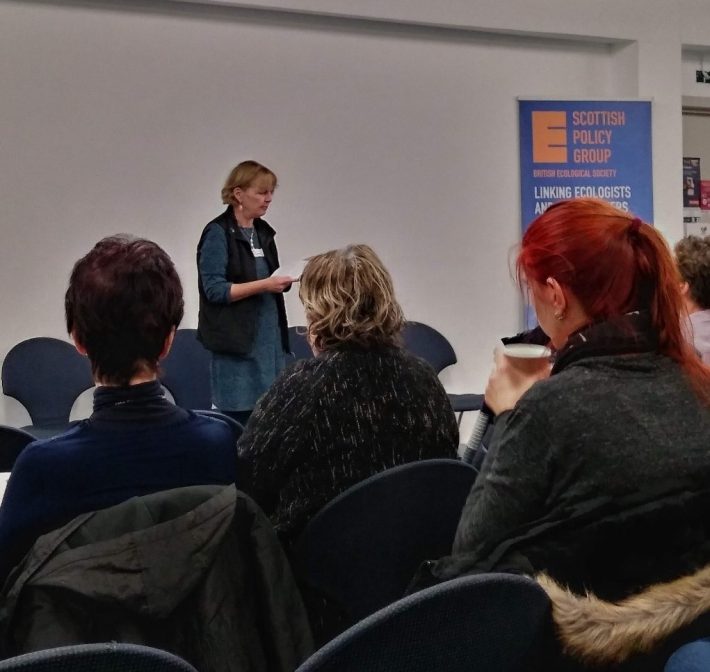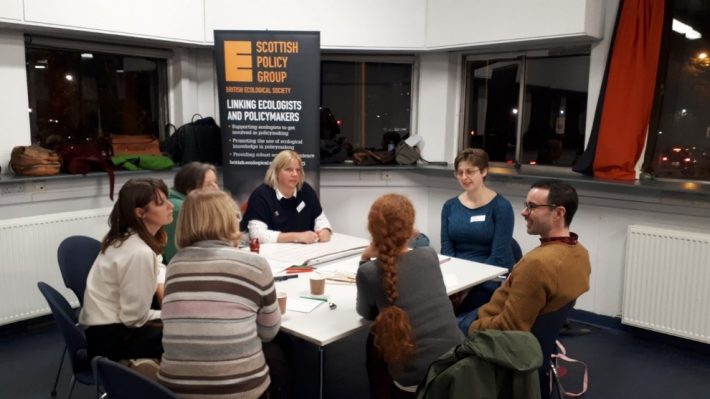How to handle ‘moving targets’ in the face of climate change
The BES Policy Intern highlights the main issues raised from the speakers and audience at the Scottish Policy Group’s autumn Pie and a Pint night.

Following a successful policy training session with early career researchers, the Scottish Policy Group headed across Edinburgh for a ‘Pie and a Pint’ event to discuss how to handle ‘moving targets’ in the face of climate change, before some networking and socialising over a well-earned pie and a pint.
We started off with a series of short pitches by our invited speakers: Dr. Althea Davies (University of St Andrews) spoke about her paleoecological research on the changing range of Scots Pine and dilemmas such as Scots Pine colonising peaty soils – posing the question of how much can we accept change and where and when can we accept it?; Nick Everett (Scottish Natural Heritage) proposed that the climate emergency we face can be seen as an opportunity to change the way we do conservation – conserving natural ecosystem functioning from substrate upwards; Prof. Anne Magurran (University of St Andrews) highlighted a thought that:
the word conservation implies constancy but actually biodiversity composition is changing at a rate much faster than ever before and we see the ‘Shopping Mall phenomenon’ with assemblages looking increasingly similar;
and Dr Flora Kent (Scottish Natural Heritage) highlighted the differences in marine and terrestrial conservation, and the difficulties in teasing apart human-driven and natural change.
Following an intriguing Q and A session, we broke into small groups and discussed the following three questions:
- What changes to species ranges and ecosystems are we willing to accept and what do we value?
- Should we engineer change to achieve pre-defined targets, or do we reduce pressures and see what happens?
- How do we reconcile policy targets and timescales with ecological evidence and its timescales?
I wanted to draw out some interesting points from the discussions:
Ecological timescales are usually too slow for us to appreciate
It might take just 50 years for saplings to grow into big trees, but it can take thousands of years to reach full ecological complexity. How may we ever be able to appreciate restoration efforts and see the outputs we might imagine?
It was suggested that success stories like the Hebridean Mink project and the eradication of the invasive ruddy duck across the UK could be used to demonstrate both the potential to succeed and the length of time it takes for a restoration projects to take its course, allowing us to see beyond that of a lifetime and buy into the potential success of long-term restoration projects.
Putting up fences – surely that isn’t engineering change, is it?
Just to place this in context, often fences are put up to exclude large herbivores, such as deer, from certain areas to reduce overgrazing. Traditionally, this has been seen as just a method of reducing grazing pressure, but from our discussions –
we realized that, actually, in the marine environment this (fencing) would be beyond imagination – it would be extreme engineering.
So how much ecological engineering should we accept? Putting up a fence on land is easily done – taking a few hours so we might not even raise an eyebrow, but to set up a fence in the marine sphere would take months, if not years of planning. Many of our reserves are carefully managed to ensure that the specific habitat types remain and if we were to stop, we would lose some like chalk grassland reserves. And are the habitats we choose to protect truly the ones of greatest conservation interest or are they limited by our experience (‘extinction of experience’)? For example, is someone born in the 50s’ likely to think flower meadows are more important than someone born in 2000?
Not only must we consider shifting targets but as ecologists we must incorporate social justice…
Climate change does not equally affect all individuals – pressures like rising sea levels, water insecurity and unpredictable weather patterns disproportionately affect low-income vulnerable communities. Moreover, climate change policies can displace many of these vulnerable individuals from jobs and practices. Our discussions made it clear that instead of considering climate change as an entirely separate issue to social justice, policies need to be developed in tandem. How might we, ecologists and policymakers, ensure that this occurs? Well the short answer is – we don’t know, but I suspect that part of the solution lies in inter-disciplinary research that informs cross-departmental policies!

Like what we stand for?
Support our mission and help develop the next generation of ecologists by donating to the British Ecological Society.